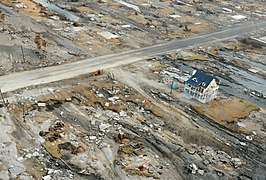Resilience (engineering and construction)
In the fields of engineering and construction, resilience is the ability to absorb or avoid damage without suffering complete failure and is an objective of design, maintenance and restoration for buildings and infrastructure, as well as communities.[1][2][3] A more comprehensive definition is that it is the ability to respond, absorb, and adapt to, as well as recover in a disruptive event.[4] A resilient structure/system/community is expected to be able to resist to an extreme event with minimal damages and functionality disruptions during the event; after the event, it should be able to rapidly recovery its functionality similar to or even better than the pre-event level.

The concept of resilience originated from ecology and then gradually applied to other fields. It is related to that of vulnerability. Both terms are specific to the event perturbation, meaning that a system/infrastructure/community may be more vulnerable or less resilient to one event than another one. However, they are not the same. One obvious difference is that vulnerability focuses on the evaluation of system susceptibility in the pre-event phase; resilience emphasizes the dynamic features in the pre-event, during-event, and post-event phases.[5]
Resilience is a multi-facet property, covering four dimensions: technical, organization, social and economic.[6] Therefore, using one metric may not be representative to describe and quantify resilience. In engineering, resilience is characterized by four Rs: robustness, redundancy, resourcefulness, and rapidity. Current research studies have developed various ways to quantify resilience from multiple aspects, such as functionality- and socioeconomic- related aspects.[5]
Equations
The first influential quantitative resilience metric based on the functionality recovery curve was proposed by Bruneau et al.,[6] where resilience is quantified as the resilience loss as follows.
where is the functionality at time ; is the time when the event strikes; is the time when the functionality full recovers.
The resilience loss is a metric of only positive value. It has the advantage of being easily generalized to different structures, infrastructures, and communities. This definition assumes that the functionality is 100% pre-event and will eventually be recovered to a full functionality of 100%. This may not be true in practice. A system may be partially functional when a hurricane strikes and may not be fully recovered due to uneconomic cost-benefit ratio.
Resilience index is a normalized metric between 0 and 1, computed from the functionality recovery curve.[7]
where is the functionality at time ; is the time when the event strikes; is the time horizon of interest.
History
Thomas Tredgold was the introduced the concept of resilience in 1818 in England.[8] The term was used to describe a property in the strength of timber, as beams were bent and deformed to support heavy load. Tredgold found the timber durable and did not burn readily, despite being planted in bad soil conditions and exposed climates.[9] Resilience was then refined by Mallett in 1856 in relation to the capacity of specific materials to withstand specific disturbances. These definitions can be used in engineering resilience due to the application of a single material that has a stable equilibrium regime rather than the complex adaptive stability of larger systems.[8][10]
In his paper Resilience and Stability of Ecological systems (1973), C.S. Holling first explored the topic of resilience through its application to the field of ecology. Ecological resilience was defined as a "measure of the persistence of systems and of their ability to absorb change and disturbance and still maintain the same relationships between state variables."[11] Holling found that such a framework can be applied to other forms of resilience. The application to ecosystems was later used to draw into other manners of human, cultural and social applications. The random events described by Holling are not only climatic, but instability to neutral systems can occur through the impact of fires, the changes in forest community or the process of fishing. Stability, on the other hand, is the ability of a system to return to an equilibrium state after a temporary disturbance. Multiple state systems rather than objects should b studied as the world is a heterogeneous space with various biological, physical and chemical characteristics.[12]
See also
Notes and references
- "Motivating business to design a more resilient nation, one building at a time" (Press release). Albuquerque, N.M.: Sandia Natiional Laboratories. 23 July 2013. Retrieved 2019-07-03.
- Jennings, Barbara J.; Vugrin, Eric D.; Belasich, Deborah K. (2013). "Resilience certification for commercial buildings: A study of stakeholder perspectives". Environment Systems and Decisions. 33 (2): 184–194. doi:10.1007/s10669-013-9440-y.
- Herrera, Manuel; Abraham, Edo; Stoianov, Ivan (2016-02-13). "A Graph-Theoretic Framework for Assessing the Resilience of Sectorised Water Distribution Networks". Water Resources Management. 30 (5): 1685–1699. doi:10.1007/s11269-016-1245-6. ISSN 0920-4741.
- https://www.resilienceshift.org/work-with-us/faqs/
- Sun, Wenjuan; Bocchini, Paolo; Davison, Brian (2018). "Resilience metrics and measurement methods for transportation infrastructure: the state of the art". Sustainable and Resilient Infrastructure: 1–32. doi:10.1080/23789689.2018.1448663.
- Bruneau, Michel; Chang, Stephanie E.; Eguchi, Ronald T.; Lee, George C.; O’Rourke, Thomas D.; Reinhorn, Andrei M.; Shinozuka, Masanobu; Tierney, Kathleen; Wallace, William A. (November 2003). "A Framework to Quantitatively Assess and Enhance the Seismic Resilience of Communities". Earthquake Spectra. 19 (4): 733–752. doi:10.1193/1.1623497. ISSN 8755-2930.
- Reed, D.A.; Kapur, K.C.; Christie, R.D. (June 2009). "Methodology for Assessing the Resilience of Networked Infrastructure". IEEE Systems Journal. 3 (2): 174–180. Bibcode:2009ISysJ...3..174R. doi:10.1109/jsyst.2009.2017396. ISSN 1932-8184.
- Baho, Didier; Allen, Craig; Garmestani, Ahjond; Fried-Petersen, Hannah; Renes, Sophia; Gunderson, Lance; Angeler, David (2017-08-30). "A quantitative framework for assessing ecological resilience". Ecology and Society. 22 (3): 1–17. doi:10.5751/ES-09427-220317. ISSN 1708-3087. PMC 5759782. PMID 29333174.
- Tredgold, Mr Thomas (1818-03-01). "XXXVII. On the transverse strength and resilience of timber". The Philosophical Magazine. 51 (239): 214–216. doi:10.1080/14786441808637536. ISSN 1941-5796.
- https://doi.org/10.1016/j.compchemeng.2017.11.002
- Hassler, Uta; Kohler, Niklaus (2014-03-04). "Resilience in the built environment". Building Research & Information. 42 (2): 119–129. doi:10.1080/09613218.2014.873593. ISSN 0961-3218.
- Holling, C.S. (September 1973). "RESILIENCE AND STABILITY OF ECOLOGICAL SYSTEMS" (PDF). Cite journal requires
|journal=(help)